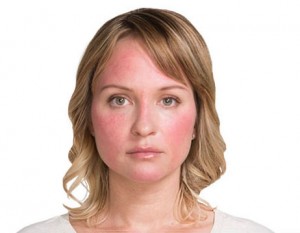Rosacea
This article was timed for release in the month of April which is Rosacea Awareness Month.
Rosy cheeks, red nose and flushed forehead are hallmarks of the chronic skin condition called rosacea. Though people of all ages, genders and ethnicities can get rosacea, there is increased predilection among certain groups. Once called the “curse of the Celts”, this skin ailment is notably common among fair skinned northern Europeans. Women are affected more often than men, but men manifest more severe forms of this condition. There are plenty of myths and misinformation about rosacea so let us dispel them systematically.

What is Rosacea?
Rosacea is often mistaken as “adult acne” due to some overlapping symptoms. Many get bumps similar to acne but the cause for these skin changes are not the same. Most of them have dilated capillaries that are present in the forehead, nose, cheek, and chin areas. These areas can undergo intense flare-ups based on certain triggers. Some people have thickened skin on the nose that eventually gets very bumpy like the famous comedian, W.C. Fields, and this condition is called rhinophyma. A sizable percentage of them have eye involvement requiring an ophthalmologist to diagnose these findings.
Triggers for Rosacea
There are several triggers that worsen the flushing symptoms. Among them are the following:
- Warm temperatures, sauna baths and being close to ovens and fireplaces can certainly change the hue very fast.
- Wine or hot beverages can worsen the symptoms. Often the patients are mistaken for alcoholics!
- Spicy foods, dairy foods, chocolate, cheese, soy sauce, citrus fruits are just a few of a long list of triggers that can turn you red.
- Certain skin products that contain alcohol, witch hazel, eucalyptus, fragrance, peppermint, or menthol will certainly work against the best interests of the rosacea patients.
- Exercise, emotional swings and also certain medical conditions can cause flare-ups.
Management and Treatment of Rosacea
The three cornerstones in treating rosacea include adhering to the prescribed medical treatment, avoiding the triggers and choosing proper skin care. It is recommended that rosacea patients carry a diary and note all the triggers that worsen their symptoms and then try avoiding them next time. The triggers that worsen the symptoms for one person may not be the same for another. Skin products that are alcohol-free, fragrance-free with ingredients meant for sensitive skin will be well suited for these patients. Microdermabrasion, strong skin peels and other harsh procedures like irritating facials will aggravate the redness.
Prescription Treatment Options
A wide array of options is available in treating the symptoms. The doctor may prescribe topical applications like Metrogel or azelaic acid which decrease the inflammation of the skin. Certain other medications like the recently FDA-approved Brimonidine help to reduce the redness of the face. Intense pulse light (IPL), or phototherapy, if carefully performed at a reputable aesthetic medical clinic, can significantly set back the progress of the skin condition.
Laser and Light Therapy Treatment Options
At Clinique Esthetique, an advanced version of IPL, called Broad Band Light (BBL), has several safety mechanisms built in to protect the skin, yet strong enough to ablate the blood vessels to rid the face of the embarrassing redness. A systematic and thorough skin consultation, followed by prescriptions that are deemed appropriate will be the first line of treatment. Several BBL phototherapy sessions spaced every few weeks will work synergistically with the medical treatment to abate the symptoms.
If you’re in the San Antonio, Texas area and are in need of rosacea treatment, call us at 1-210-545-5344 for a free, detailed consultation.
